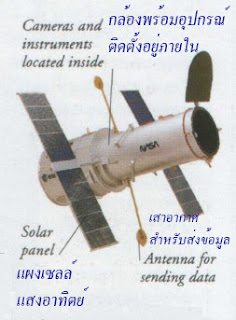ASTRONOMY
ASTRONOMY is THE
STUDY OF SPACE and everything it contains.
It is a subject that has been studied since ancient
times when humans used their eyes to gaze out at the
stars and planets. Today's astronomers use
sophisticated equipment to collect information about space and how the Universe as a whole works.
|
ดาราศาสตร์
ดาราศาสตร์คือการศึกษาเกี่ยวกับอวกาศและทุกสิ่งทุกอย่างที่อยู่ในอวกาศ
เป็นวิชาที่ศึกษากันมาตั้งแต่ยุคโบราณกาล
ในขณะที่มนุษย์ใช้สายตาจ้องมองออกไปที่ดาวฤกษ์และดาวเคราะห์ นักดาราศาสตร์ยุคปัจจุบันใช้เครื่องมือที่ช่ำชองเพื่อรวบรวมข้อมูลเกี่ยวกับอวกาศและการทำงานทุกอย่างเกี่ยวกับจักรวาล
|
||
Observatories
An astronomer's
telescopic equipment is housed and used in an
observatory. The atmosphere distorts light and other radiations from space, so many
observatories are located at high altitudes.
|
หอดูดาวหรือหอสังเกตการณ์
อุปกรณ์กล้องส่องทางไกลของนักดาราศาสตร์จะถูกติดตั้งไว้และใช้ในหอดูดาวหรือหอสังเกตการณ์
บรรยากาศจะทำให้แสงและรัศมีอื่น ๆ จากอวกาศเกิดความบิดเบี้ยว ดังนั้น
หอดูดาวจึงติดตั้งไว้ในระดับที่สูงเหนือระดับน้ำทะเล
|
||
Optical observatory
The world's biggest
optical observatories are on mountaintops, away from
city lights and where the atmosphere is clear and dry. The
Kitt Peak National Observatory, which has 22 major
telescopes, is on a 2,100-m (6,900-ft) mountain in Arizona, USA. Observatories sited in such inaccessible
places need support services for the astronomers and their equipment,
including accommodation, workshops, and transport.
|
หอดูดาวด้วยตาเปล่า
หอดูดาวด้วยตาเปล่าที่ใหญ่ที่สุดของโลกอยู่บนยอดภูเขา
ไกลออกไปจากแสงไฟในเมืองและสถานที่ที่มีบรรยากาศที่มีท้องฟ้าแจ่มใสและไร้ฝน
หอดูดาวแห่งชาติคิท พีค (Kitt Peak National Observatory) ซึ่งมีกล้องโทรทรรศน์ขนาดใหญ่ 22 ตัว อยู่บนภูเขาสูง 2,100 เมตร
(6,900 ฟุต) ในรัฐแอริโซนา สหรัฐอเมริกา
หอดูดาวตั้งอยู่ในสถานที่ที่ไปถึงยากเช่นนั้นจำเป็นต้องมีการบริการสนับสนุนให้นักดาราศาสตร์และอุปกรณ์ของพวกเขา
ประกอบด้วยสิ่งอำนวยความสะดวก การประชุมปฏิบัติการ และการขนส่ง
|
||
Radio observatory
Radio waves are
largely unaffected by the atmosphere, so radio
telescopes can be sited virtually anywhere.
The 305-m (1,000-ft) Arecibo radio dish (above) is in a natural hollow on the island of
Puerto Rico. It is the world's
largest single radio dish.
หอดูดาววิทยุ
คลื่นวิทยุโดยทั่วไปไม่ได้รับผลกระทบจากบรรยากาศ
ดังนั้น กล้องโทรทรรศน์วิทยุจึงสามารถติดตั้งได้เกือบทุกที่ จานวิทยุอาเรซีโช (Arecibo) สูง 305 เมตร (1,000 ฟุต) อยู่ในหุบเขาธรรมชาติบนเกาะในประเทศปวยร์โตรีโก เป็นจานสัญญาวิทยุแบบจานเดี่ยวขนาดใหญ่ที่สุดของโลก
|
|||
Astronomers' tools
Astronomers collect
data from space by analysing a range of electromagnetic radiations; light and radio waves as well as other
wavelengths such as X-ray, infrared, and
ultraviolet. Astronomers use specialized telescopes
with various attachments for collecting and studying the
data.
|
เครื่องมือของนักดาราศาสตร์
นักดาราศาสตร์จะเก็บรวบรวมข้อมูลจากอวกาศด้วยการวิเคราะห์ขอบเขตของรัศมีแม่เหล็กไฟฟ้า
คลื่นแสงและคลื่นวิทยุตลอดจนความยาวของคลื่นอื่น ๆ เช่น รังสีเอ็กซ์ อินฟาเรด
และอัลตราไวโอเล็ต นักดาราศาสตร์จะใช้กล้องโทรทรรศน์พิเศษกับอุปกรณ์ยึดติดต่าง
ๆ เพื่อเก็บรวบรวมและศึกษาข้อมูล
|
||
Space observatory
Telescopes in space collect data 24 hours a day and transmit it back to Earth. The Hubble Space Telescope, launched in 1990, orbits Earth, collecting data from optical and ultraviolet wavelengths.
หอสังเกตการณ์อวกาศ
กล้องโทรทรรศน์ในอวกาศจะเก็บรวบรวมข้อมูลได้ตลอด 24 ชั่วโมงต่อวันและถ่ายทอดกลับมายังโลก กล้องโทรทรรศน์อวกาศฮับเบิลที่ปล่อยไปในอวกาศเมื่อปี ค.ศ. 1990 (พ.ศ. 2533) จะโคจรรอบโลกเพื่อเก็บรวบรวมข้อมูลจากความยาวคลื่นแสงและอัลตราไวโอเล็ต
|
|||
Telescope
The finest and most powerful telescopes use one or more mirrors to collect light from a distant object and form an image. Electronic devices or photographic plates rather than the eye collect the data. Other attachments, such as spectroscopes and photometers, help analyse light emitted by stars.
กล้องโทรทรรศน์
กล้องโทรทรรศน์ที่ยอดเยี่ยมที่สุดและมีประสิทธิภาพมากที่สุดจะใช้กระจกหนึ่งแผ่นหรือมากกว่าเพื่อรวมแสงจากวัตถุที่อยู่ห่างไกลและสร้างเป็นรูปภาพขึ้น อุปกรณ์อิเล็กทรอนิกส์และแผ่นภาพถ่ายที่พิมพ์ออกมาเก็บรวบรวมข้อมูลได้ค่อนข้างดีกว่าใช้สายตาเก็บรวบรวมข้อมูล อุปกรณ์ยึดติดอื่น ๆ เช่น กล้องศึกษาสเปกตรัมและเครื่องวัดความสว่างหรือระดับความเข้มของแสง จะช่วยวิเคราะห์แสงที่ดาวฤกษ์ปล่อยออกมา
|
|||
Space probe
Objects in the Solar
System have been studied at close hand
by space probes. Instruments perform a host
of investigations, including making detailed
images of planets and their moons, and analysing
what they are made of. Two
identical Viking probes investigated Mars
in 1976.
การสำรวจอวกาศ
วัตถุในระบบสุริยะจะได้รับการศึกษาอย่างใกล้ชิดด้วยการสำรวจอวกาศ
อุปกรณ์ดำเนินการสำรวจจำนวนมาก ประกอบด้วย
การทำรายละเอียดรูปภาพของดาวเคราะห์และดวงจันทร์บริวาร และการวิเคราะห์ว่าสิ่งเหล่านั้นเกิดขึ้นจากอะไร
ยานสำรวจไวกิ้งที่มีชื่อเหมือนกัน 2 ลำ (ไวกิ้ง 1 และ 2) ได้สำรวจดาวอังคารในปี
ค.ศ. 1976 (พ.ศ. 2519)
|
|||
Astronomer
at work
Most
astronomers specialize in one area of
research, such as planetary geology, interplanetary
dust, stellar development, galaxy
formation, or
quasars. Whatever the subject, an astronomer can be found in one of two main
locations: in universities and observatories.
|
นักดาราศาสตร์ขณะทำงาน
นักดาราศาสตร์ส่วนใหญ่จะมีความเชี่ยวชาญในสาขาของการวิจัยหนึ่งสาขา เช่น ธรณีวิทยาของดาวเคราะห์ ฝุ่นระหว่างดาวเคราะห์ วิวัฒนาการของดาวฤกษ์ การเกิดขึ้นของกาแล็กซี หรือเควซาร์ ไม่ว่าจะเป็นสาขาใดก็ตาม นักดาราศาสตร์ก็จะสามารถค้นพบได้ในสถานที่แห่งหนึ่งในบรรดาสองแห่งที่สำคัญ คือ ในมหาวิทยาลัยและหอสังเกตการณ์
|
||
ObservationOnly a fraction of an astronomer's time is spent observing. Instead, most of the data comes from observations made and recorded by other astronomers on big telescopes, or from automatic equipment on space probes. The observations are used to help build theories or to confirm an established theory, such as how stars form. การสังเกต นักดาราศาสตร์ใช้เวลาเพียงเศษเสี้ยวหนึ่งเท่านั้นในการสังเกต ข้อมูลส่วนใหญ่ได้มาจากการสังเกตการณ์ที่นักดาราศาสตร์คนอื่น ๆ กระทำและบันทึกไว้ในกล้องโทรทรรศน์ขนาดใหญ่หรือจากอุปกรณ์อัตโนมัติบนยานสำรวจอวกาศแทน การสังเกตใช้เพื่อช่วยเหลือในการสร้างทฤษฎีหรือเพื่อยืนยันทฤษฎีที่ได้รับการยอมรับ เช่น ดาวฤกษ์เกิดขึ้นได้อย่างไร
|
|||
Data collectionThe CCD, an electronic chip that records data from space, can collect enough data in a few hours to keep an astronomer busy for years. การเก็บรวบรวมข้อมูล อุปกรณ์ถ่ายเทประจุ (CCD = charge-coupled device) ซึ่งเป็นชิปอิเล็กทรอนิกส์ที่บันทึกข้อมูลจากอวกาศ สามารถรวบรวมข้อมูลได้มากภายในไม่กี่ชั่วโมงเพื่อดูแลนักดาราศาสตร์ผู้ที่มีงานยุ่งเป็นเวลาแรมปี
|
|||
AnalysisData can be collected directly on to a computer and then transferred to other computers for analysis. Computers can process images and handlelarge amounts of information much more quickly than an astronomer.
การวิเคราะห์
ข้อมูลสามารถเก็บรวบรวมไว้โดยตรงในคอมพิวเตอร์และแล้วก็สามารถถ่ายโอนไปยังคอมพิวเตอร์เครื่องอื่น
ๆ เพื่อการวิเคราะห์ คอมพิวเตอร์สามารถประมวลผลภาพและจัดการข้อมูลจำนวนมากได้เร็วกว่านักดาราศาสตร์
|
|||
|
Fred Hoyle
The British
astronomer Fred Hoyle (1915-2001) helped to solve some of the most
baffling questions facing 20th-century
astronomers. A major breakthrough was explaining
nucleosynthesis — how chemical
elements are produced from the hydrogen inside stars. He also wrote science fiction novels.
เฟรด ฮอยล์
เฟรด ฮอยล์ (Fred Hoyle) นักดาราศาสตร์ชาวอังกฤษ (ค.ศ.1915-2001 = พ.ศ. 2458-2544 อายุ 86 ปี) ได้ช่วยแก้ปัญหาที่ยุ่งเหยิงที่สุดบางอย่างที่นักดาราศาสตร์ในศตวรรษที่ 20 เผชิญอยู่ การพัฒนาที่สำคัญคือการอธิบายการสังเคราะห์นิวเคลียส (Nucleosynthesis) คือวิธีการที่ธาตุทางเคมีผลิตจากไฮโดรเจนภายในดาวฤกษ์ นอกจากนี้เขายังได้เขียนนวนิยายวิทยาศาสตร์ด้วย
|
|
||
|
Timeline
1609 First use of
the telescope for the systematic
study of space.
|
1923
Astronomers observe galaxies other than
the Milky Way.
|
1999
Hubble telescope sights 18 other galaxies up to 65 million years away.
|
|
|
1781 Discovery of Uranus doubled the diameter of the known Solar System.
|
1963
Quasars is discovered
|
|
|
|
1863 Analysis of starlight shows stars are made of the same elements as those
on Earth.
|
1987 Supernova 1987A explodes.
|
|
|
|
|
|
|
|
|
เส้นเวลา
ค.ศ. 1609 (พ.ศ. 2152) มีการใช้กล้องโทรทรรศน์ในการศึกษาอวกาศอย่างเป็นระบบเป็นครั้งแรก
|
ค.ศ. 1923 (พ.ศ. 2466) นักดาราศาสตร์สังเกตกาแล็กซีอื่นนอกเหนือจากทางช้างเผือก
|
ค.ศ. 1999 (พ.ศ. 2542) กล้องโทรทรรศน์ฮับเบิลได้สำรวจกาแล็กซีอื่น
ๆ อีก 18 แห่ง ซึ่งอยู่ห่างออกไปถึง 65 ล้านปีแสง
|
|
ค.ศ. 1781 (พ.ศ. 2324) มีการค้นพบดาวยูเรนัส ซึ่งมีเส้นผ่านศูนย์กลางเป็นสองเท่าของระบบสุริยะที่รู้จักกันดี
|
ค.ศ. 1963 (พ.ศ. 2506) ค้นพบเควซาร์
|
|
|
|
ค.ศ. 1863 (พ.ศ. 2406) การวิเคราะห์แสงดาวแสดงให้เห็นว่าดาวฤกษ์เกิดจากธาตุเดียวกันกับธาตุที่อยู่บนโลก
|
ค.ศ. 1987 (พ.ศ. 2530) มหานวดาราหรือซูเปอร์โนวา
1987A ระเบิด
|
|
|












